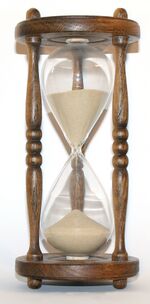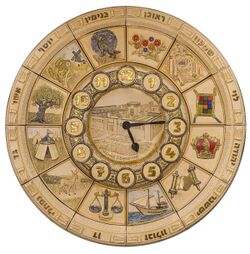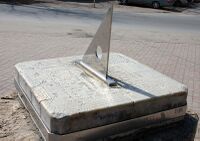| 时间 |
|---|
 |
| 现在时间 (更新) |
| 2024年4月26日 19:58 (UTC) |

时间是一种尺度,在物理定义是标量,借着时间,事件发生之先后可以按过去-现在-未来之序列得以确定(时间点/时刻),也可以衡量事件持续的期间以及事件之间和间隔长短(时间段)[1][2] 。在闵考斯基时空中,时间是除了空间三个维度以外的第四维度[3]。 长久以来,时间一直是宗教、哲学及科学领域的研究主题之一,但学者们尚且无法为时间找到一个可以适用于各领域、具有一致性且又不循环的定义[4]。然而在商业、工业、体育、科学及表演艺术等领域都有一些各自来标示及度量时间的方法[5][6][7]。一些简单,争议较小的定义包括“时间是时钟量测的物理量。”及“时间使得所有事情不会同时发生。”[8][9][10][11]时间在国际单位制中的基本单位是秒,1967年起采用的定义为“铯-133原子在基态下的两个超精细能级之间跃迁所对应的辐射的9192631770个周期的时间。”
哲学家对于时间有两派不同的观点:一派认为时间是宇宙的基本结构,是一个会依序列方式出现的维度,像艾萨克·牛顿就对时间有这样的观点。包括戈特弗里德·莱布尼茨及伊曼努尔·康德在内的另一派认为时间不是任何一种已经存在的维度,也不是任何会“流动”的实存物,时间只是一种心智的概念,配合空间和数可以让人类对事件进行排序和比较。换句话说,时间不过是人为便于思考宇宙,而对物质运动划分,是一种人定规则。
其他方言的称谓
时间在粤语中亦称为时间,在吴语中称为辰光。
丈量与记录
计时仪器

中国古代的计时仪器有太阳钟和机械钟两类。太阳钟是以太阳的投影和方位来计时,分别以土圭、圭表、日晷为代表。由于地球轨道偏心率以及地球倾角的影响,真太阳时和平太阳时是不一致的,机械钟应运而生,代表有水钟、香篆钟、太阳仪。
单位
时间的基本国际单位是秒。它现在以铯133原子基态的两个超精细能级间跃迁对应的辐射的9,192,631,770个周期的持续时间为标准[12]。
物理学

目前最广泛被接受关于时间的物理理论是阿尔伯特·爱因斯坦的相对论。在相对论中,时间与空间一起组成四维时空,构成宇宙的基本结构。时间与空间都不是绝对的,观察者在不同的相对速度或不同时空结构的测量点,所测量到时间的流易是不同的。狭义相对论预测一个具有相对运动的时钟之时间流易比另一个静止的时钟之时间流易慢。在1971年,物理学家哈菲尔(Joe Hafele)与基廷(Richard Keating)做了证明。他们将高度精确的原子钟放在飞机上绕着世界飞行,然后将读到的时间与留在地面上完全一样的时钟做比较。结果证实:在飞机上的时间流易得比实验室里的慢。据爱因斯坦的理论,当移动的速度越快,时间流易速度越慢,当移动速度达到光速的一半时,时间约慢13%。
另外,广义相对论预测质量产生的重力场将造成扭曲的时空结构,并且在大质量(例如黑洞)附近的时钟之时间流易比在距离大质量较远的地方的时钟之时间流易要慢。现有的仪器已经证实了这些相对论关于时间所做精确的预测,并且其成果已经应用于全球定位系统。
就今天的物理理论来说时间是连续的,不间断的,也没有量子特性。但有一些理论试图将相对论与量子力学结合起来,如量子引力,弦理论,M理论,预言时间是间断的,有量子特性的;但它们还没有被实验证明过的。另有一些理论猜测普朗克时间可能才是时间的最小单位。
根据史提芬·霍金所解出广义相对论中的爱因斯坦方程式,显示宇宙的时间是有一个起始点,由大霹雳(或称大爆炸)开始的,在此之前的时间是毫无意义的。而物质与时空必须一起并存,没有物质存在,时间也无意义。
人出生、成长、衰老、死亡,没有反过来的。玻璃瓶掉到地上摔破,没有破瓶子从地上跳起来合整的。古典力学无法解释时间的不可逆性。两个粒子弹性碰撞的过程顺过来反过去没有实质上的区别。时间的不可逆性只有在统计力学和热力学的观点下才可被理论地解释。热力学第二定律说在一个封闭的系统中(我们可以将宇宙看成是最大的可能的封闭系统)熵只能增大,不能减小。宇宙中的熵增大后不能减小,因此时间是不可逆的。
天文学
最早研究时间的科学不是物理学,而是天文学。天文学的一个最重要的任务就是测量时间,从确定日的长短,四季的变化,到制定历法。在古代中国和在西方一样,制定历法的需要是推动天文学理论发展的重要因素之一。
今天的天文学已与历法或时间测量毫无关联了,但天文学观测对时间概念的发展依然非常重要。天体发出的光到地球上被观测到需要一定的时间。离地球越远的天体发出的光需要的时间也越长,因此对宇宙越远的地方的观测也是对宇宙越古老的时间的观测。现在最被公认的宇宙学理论(宇宙大爆炸理论)认为时间与空间和宇宙内的质能一样是在140亿年前产生的。目前的天文学观测估计宇宙的扩展是没有尽头的,因此时间也应该是没有尽头的。
哲学
传统哲学对时间研究:古代的本体论采取独断的口吻宣布时间的本质和属性,近代的认识论采取主客对立、非此即彼的态度判断时间的本质和属性,近现代的现象学和存在论者则从抽象的人出发去探索时间的本质问题。[来源请求]
现在哲学家对于时间有两派不同的观点:一派认为时间是宇宙的基本结构,是一个会依序列方式出现的维度,艾萨克·牛顿就对时间有这样的观点,因此也称为“牛顿式的时间”[13]。另一派认为时间不是任何一种已经存在的维度,也不是任何会“流动”的实存物,时间只是一种心智的概念,配合空间和数可以让人类对事件排先后顺序及进行比较[14]。依照戈特弗里德·莱布尼茨及伊曼努尔·康德的传统[15][16],第二派的观点认为空间和时间“本身并不存在,而是我们表达事物方式的产物”,
宗教
科学对时间的存在观察,提供人类从自身既有的见解与实据出发 。宗教对时间的存在启发,即在于补足人类历代科学见解的不足之处,提出存在可能相对的观点与反思:
1.关于时间的形态问题:有循环时间观和线性时间观。
2.对时间结构的取向问题:过去取向、现在取向、未来取向。
3.时间存在的方式问题:线性存在、非线性存在、瞬时存在的“点”、跨点存在的时间段(线段的形式),形象是清晰、模糊。www.baohuasi.org/e_book/xz-13641.pdf
基督教、犹太教等对时间的纪录见诸《圣经》记载,形成圣经神学与系统神学等帮助人深入探讨时间的真实性,例如:“主看一日如千年,千年如一日。”《彼得后书3:8》,涉及提示出“地球时间”与“宇宙时间”的差异观念。[来源请求]
文学
在文学中,时间的流易和不可逆性是一个古今中外一再提到的内容。光阴似箭,日月如梭,这句谚语既体现了古人对时间的最直接的领会:日与夜光与阴的交汇,也体现了古人对时间不可逆性的认识以及对此的感慨。
时间的使用方式
在社会学和人类学中,时间纪律是社会和经济规则,惯例,习俗和期望的统称,用于衡量时间,社会货币和时间测量意识以及人们对他人遵守这些习俗的期望。 Arlie Russell Hochschild 和 Norbert Elias从社会学的角度写了关于时间的使用。
时间的使用方式是理解人类行为,教育和旅行行为的重要问题。时间使用方式的研究是一个发展中的研究领域。问题涉及如何在多个活动中分配时间(例如在家中,在工作中,购物等处花费的时间)。随着技术的发展,时间会有所变化,因为电视或互联网创造了以不同方式利用时间的新机会。然而,时间使用方式的某些方面在很长一段时间内相对稳定,例如上班通勤时间,尽管交通情况有很大差异,但据观察,单程大约20-30分钟是很多城市的情况。
时间管理是先组织任务或事件,首先估计一个任务需要多少时间以及什么时候必须完成,并调整干扰其完成的事件,以便在适当的时间内完成。日历和日程安排是时间管理工具的常见例子。
一系列事件或一系列事件是按时间顺序(时间顺序)排列的项目,事实,事件,动作,变化或程序步骤的序列,通常在项目之间具有因果关系。由于因果关系,原因先于效应,或者因果关系可能在单个项目中一起出现,但效果决不会先于原因。一系列事件可以用文字,表格,图表或时间表显示。项目或事件的描述可能包括时间戳。包括时间以及地点或位置信息以描述顺序路径的一系列事件可被称为世界线。
一系列事件的使用包括故事,历史事件(年表),程序中的方向和步骤以及计划活动的时间表。一系列事件也可以用来帮助描述科学,技术和医学过程。一系列事件可能集中在过去的事件(例如故事,历史,年代表)上,未来事件必须按照预定的顺序(例如计划,时间表,程序,时间表),或者集中于观察过去的事件预期事件将在未来发生(例如过程,预测)。一系列事件的发生在机器(摄像机定时器),纪录片(灾难秒),法律(法律选择),计算机模拟(离散事件模拟)和电力传输(序列事件记录器)。一系列事件的一个具体例子是福岛第一核灾难的时间表。
参见
参考文献
- ↑
Oxford Dictionaries:Time. Oxford University Press. 2011 [2011-12-18].
the indefinite continued of existence and events in the past, present, and future regarded as a whole
- ↑
Webster's New World College Dictionary. 2010 [2011-04-09].
1.indefinite, unlimited duration in which things are considered as happening in the past, present, or future; every moment there has ever been or ever will be… a system of measuring duration 2.the period between two events or during which something exists, happens, or acts; measured or measurable interval
- ↑ "Newton did for time what the Greek geometers did for space, idealized it into an exactly measurable dimension." About Time: Einstein's Unfinished Revolution, Paul Davies, p. 31, Simon & Schuster, 1996, ISBN 978-0-684-81822-1
- ↑ Sean M Carroll. From Eternity to Here: The Quest for the Ultimate Theory of Time. Dutton. 2009. ISBN 978-0-525-95133-9.
- ↑
Official Baseball Rules, 2011 Edition. Rules 8.03 and 8.04 (Free PDF download). Major League Baseball. 2011 [2012-07-07].
Rule 8.03 Such preparatory pitches shall not consume more than one minute of time...Rule 8.04 When the bases are unoccupied, the pitcher shall deliver the ball to the batter within 12 seconds...The 12-second timing starts when the pitcher is in possession of the ball and the batter is in the box, alert to the pitcher. The timing stops when the pitcher releases the ball
- ↑
Guinness Book of Baseball World Records. Guinness World Records, Ltd. [2012-07-07].
The record for the fastest time for circling the bases is 13.3 seconds, set by Evar Swanson at Columbus, Ohio in 1932...The greatest reliably recorded speed at which a baseball has been pitched is 100.9 mph by Lynn Nolan Ryan (California Angels) at Anaheim Stadium in California on 20 August 1974.
- ↑ Zeigler, Kenneth. Getting organized at work : 24 lessons to set goals, establish priorities, and manage your time. McGraw-Hill. 2008. ISBN 9780071591386. 108 pages
- ↑ Cummings, Raymond King. The Girl in the Golden Atom. U of Nebraska Press. 1922: 46. ISBN 978-0-8032-6457-1. Chapter 5. Cummings repeated this sentence in several of his novellas. Sources, such as this one, attribute it to his earlier work, The Time Professor, in 1921. Before taking book form, several of Cummings's stories appeared serialized in magazines. The first eight chapters of his The Girl in the Golden Atom appeared in All-Story Magazine on 15 March 1919. In the novel version the quote about time appears in Chapter V.
- ↑ International, Rotary. The Rotarian. Published by Rotary International: 47. Aug 1973. ISSN 0035-838X. , What does a man possess? page 47
- ↑ Daintith, John. Biographical Encyclopedia of Scientists third. CRC Press. 2008: 796. ISBN 1-4200-7271-4. , Page 796, quoting Wheeler from the American Journal of Physics, 1978
- ↑ Davies, Davies. About time: Einstein's unfinished revolution. Simon & Schuster. 1995: 236. ISBN 0-671-79964-9.
- ↑ Leap Seconds. Time Service Department, United States Naval Observatory. [2006-12-31].
- ↑
Markosian, Ned. Time. Edward N. Zalta (编). The Stanford Encyclopedia of Philosophy (Winter 2002 Edition). [2011-09-23].
The opposing view, normally referred to either as “Platonism with Respect to Time” or as “Absolutism with Respect to Time,” has been defended by Plato, Newton, and others. On this view, time is like an empty container into which events may be placed; but it is a container that exists independently of whether or not anything is placed in it.
- ↑ Navratil, Gerhard. Research Trends in Geographic Information Science. Springer Japan. 2009: 217. ISBN 3-540-88243-X.
- ↑
Mattey, G. J. : UC Davis. Critique of Pure Reason, Lecture notes: Philosophy 175 UC Davis. 1997-01-22 [2011-04-09].
What is correct in the Leibnizian view was its anti-metaphysical stance. Space and time do not exist in and of themselves, but in some sense are the product of the way we represent things. The[y] are ideal, though not in the sense in which Leibniz thought they are ideal (figments of the imagination). The ideality of space is its mind-dependence: it is only a condition of sensibility.... Kant concluded "absolute space is not an object of outer sensation; it is rather a fundamental concept which first of all makes possible all such outer sensation."...Much of the argumentation pertaining to space is applicable, mutatis mutandis, to time, so I will not rehearse the arguments. As space is the form of outer intuition, so time is the form of inner intuition.... Kant claimed that time is real, it is "the real form of inner intuition."
- ↑
McCormick, Matt : California State University, Sacramento. Immanuel Kant (1724–1804) Metaphysics: 4. Kant's Transcendental Idealism. The Internet Encyclopedia of Philosophy. 2006 [2011-04-09].
Time, Kant argues, is also necessary as a form or condition of our intuitions of objects. The idea of time itself cannot be gathered from experience because succession and simultaneity of objects, the phenomena that would indicate the passage of time, would be impossible to represent if we did not already possess the capacity to represent objects in time.... Another way to put the point is to say that the fact that the mind of the knower makes the a priori contribution does not mean that space and time or the categories are mere figments of the imagination. Kant is an empirical realist about the world we experience; we can know objects as they appear to us. He gives a robust defense of science and the study of the natural world from his argument about the mind's role in making nature. All discursive, rational beings must conceive of the physical world as spatially and temporally unified, he argues.
外部链接
- 倪梁康:〈纵意向性:时间.发生.历史〉(2010)
- 黄俊杰:〈传统中国历史思想中的“时间”与“超时间”概念〉
- 时间科普网站(中国)
- 国家地理频道专题影片《超乎想像的宇宙-时间扭曲》